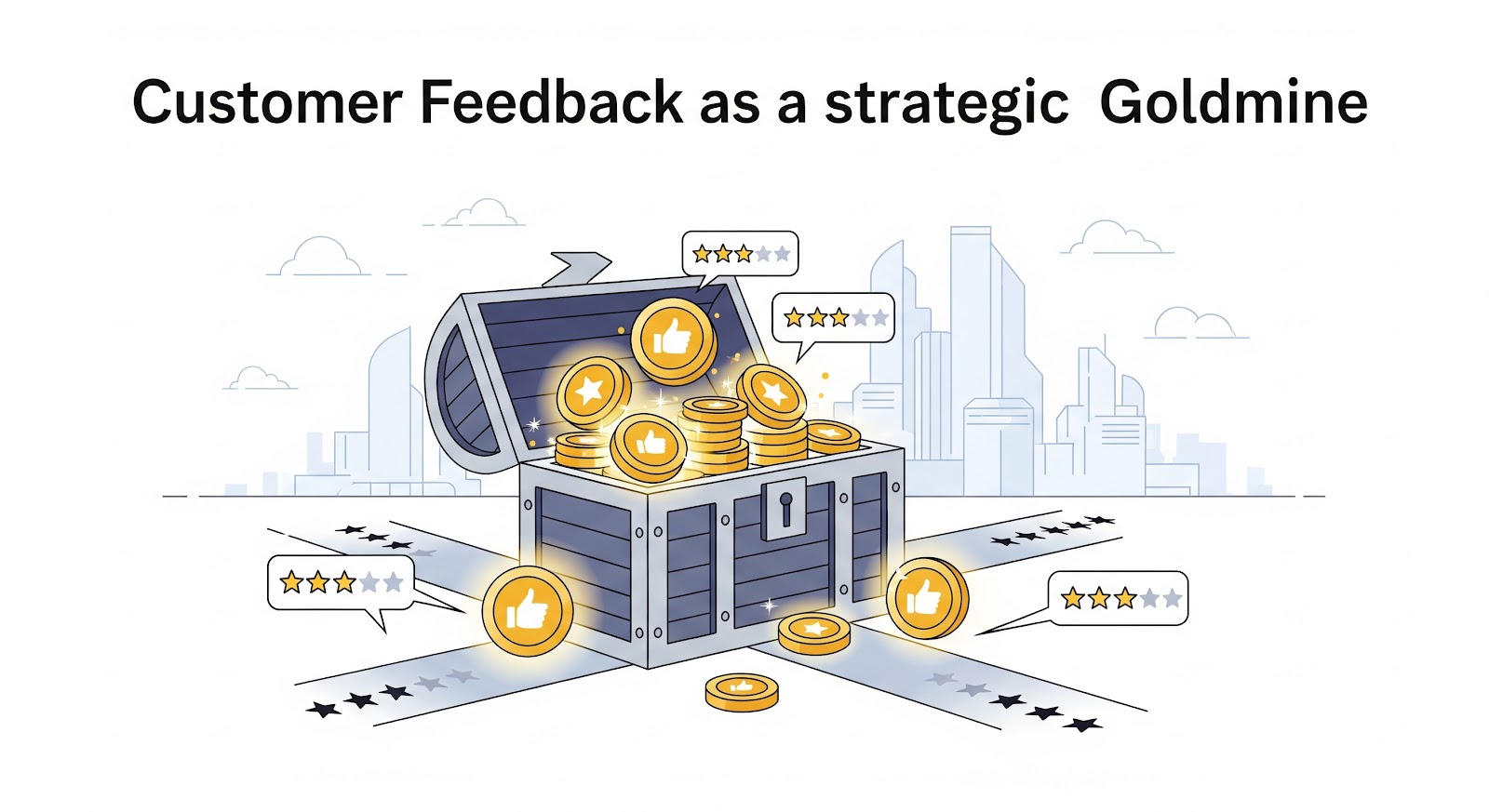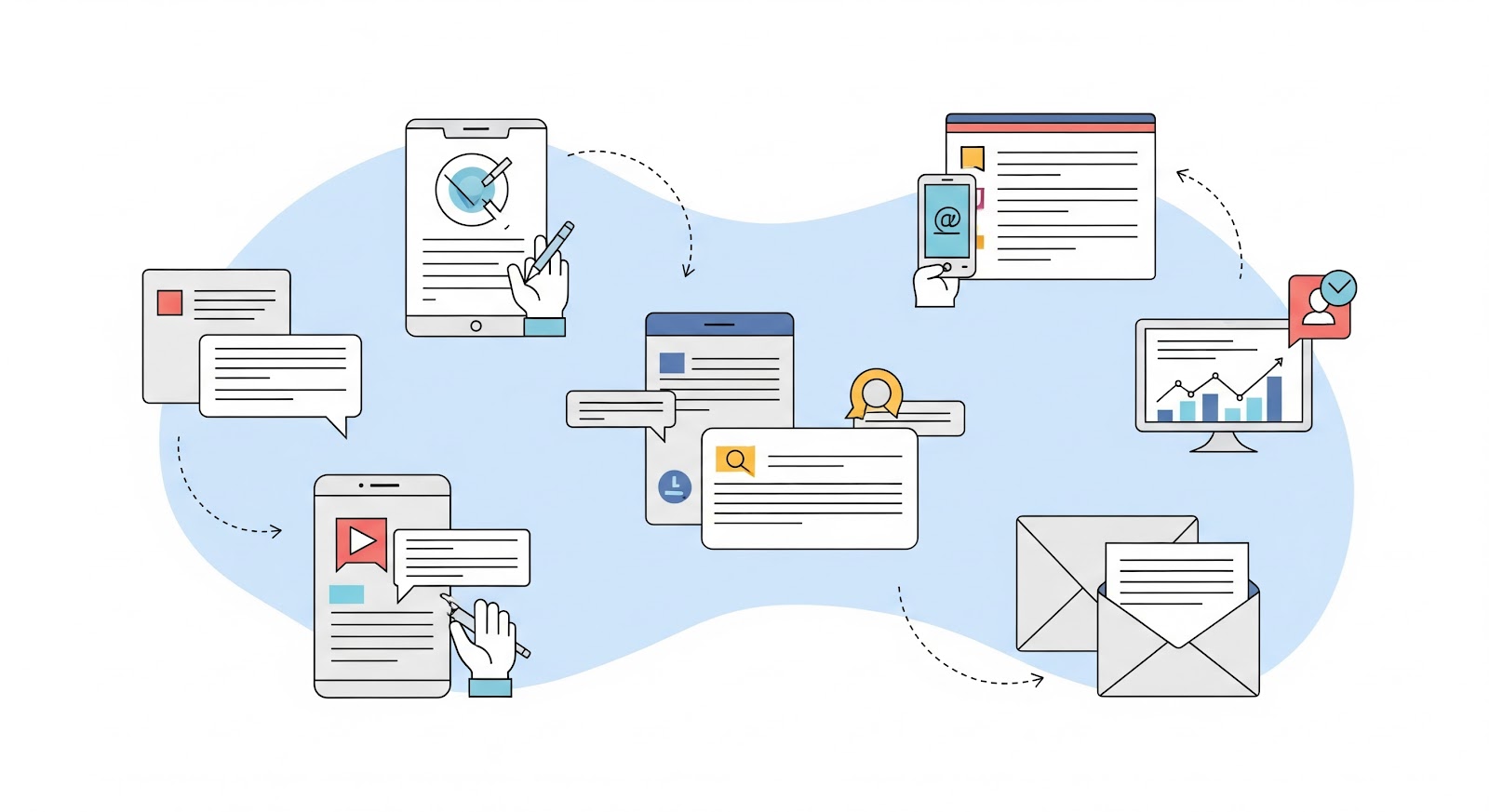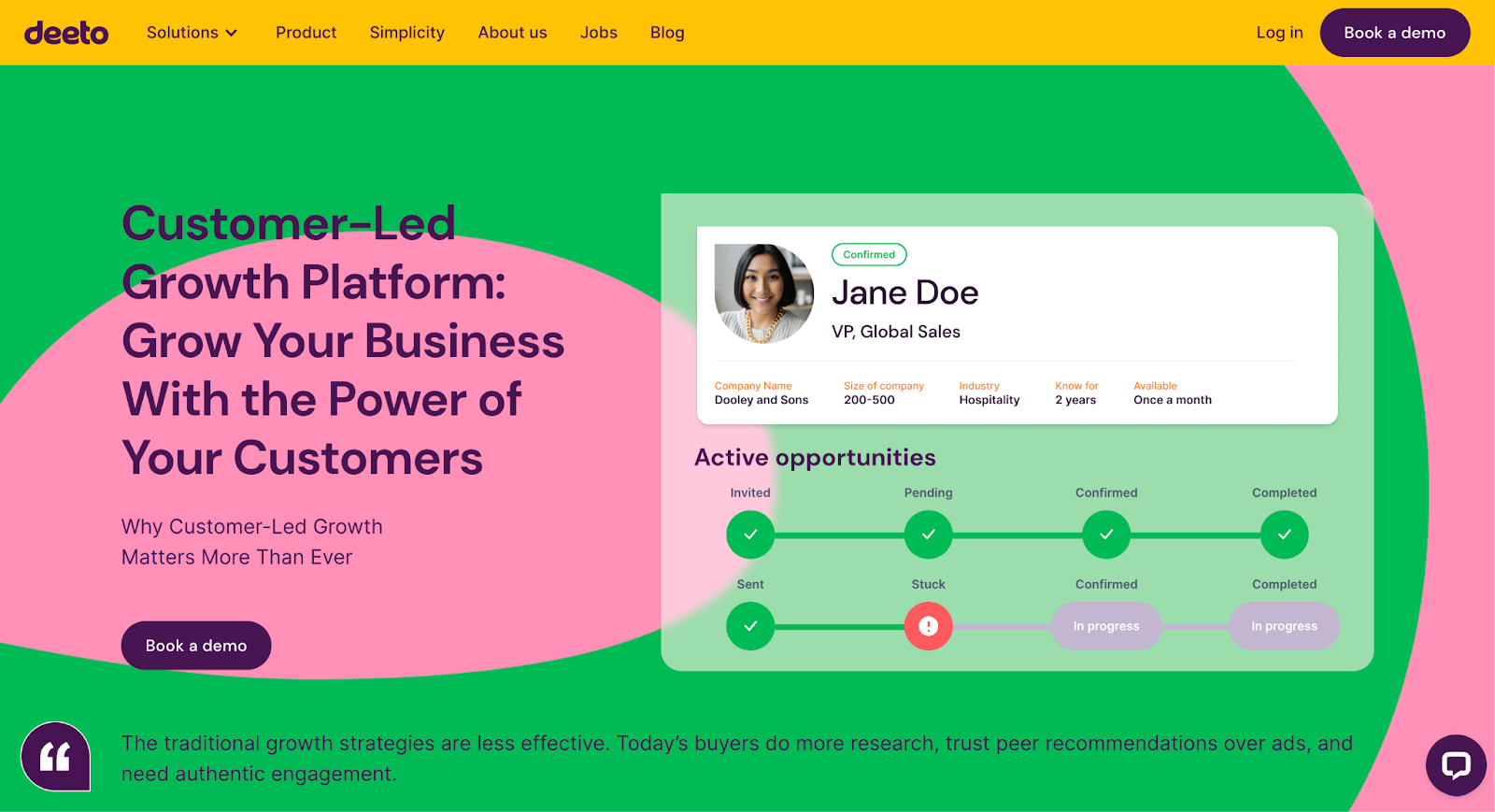Your customers are already telling you what works and what doesn’t. The question is: are you listening?
Buyers don’t take marketing claims at face value. They look to peers, read reviews, and rely on others’ experiences to make sense of it all.
That’s why customer feedback isn’t just a support or product function. When you integrate it into your marketing, you’re aligning your message with what real customers value, need, and say. And you’re adding a ‘proof’ factor that no other kind of messaging can replicate.
Why customer feedback is a strategic goldmine

Customer feedback gives you unfiltered insight into what your audience cares about: pain points, priorities, objections, and outcomes.
While on the surface that sounds more like a product or sales issue, you have to consider the fact that the vast majority (roughly 70%) of the B2B buyer's journey happens before talking to sales. Not to mention, how effectively your product solves their pain points only matters once they’ve actually entered your funnel.
Marketing is how you get them there in the first place. If your messaging doesn’t reflect what customers actually care about, it won’t get them interested enough to keep browsing, let alone book a 30-minute demo.
How feedback loops have evolved in B2B marketing
B2B feedback loops used to be slow and surface-level. You’d run a quarterly survey or collect NPS scores and react after the fact. Better than nothing, but far from strategic.
Now, feedback loops are two-pronged:
- Explicit feedback fuels content creation.
- Behavioral data personalizes delivery at scale.
You talk to customers, read reviews, analyze objections, and gather quotes. That gives you the raw material: what matters, what converts, what language resonates.
Once that marketing collateral exists, your systems take over. CMS and email platforms track what buyers click, download, and engage with, then automatically serve up more content like it. That’s the predictive layer that adapts to each buyer’s journey in real time.
But none of that automation works unless the core content hits. And it only hits if it’s grounded in real, unfiltered customer insight.
The shift toward customer-led growth
Really, customer-led growth is a natural response to the increasing number of options in nearly every purchase category (many of which are commoditized) and the simultaneous improvement in software's capacity to deliver better experiences.
The only real way to perfect a product, market it better, and sell it more effectively is to relentlessly apply the feedback of the people who are already using it successfully to all those areas, respectively. That’s how you retain your users and attract more just like them.
From a marketing perspective, your messaging, positioning, and content strategy all have to be reverse-engineered from what already-successful customers actually think, say, and care about. Not what your team assumes they care about.
Each piece of content has to be served on a case-by-case basis. Almost two-thirds of B2B buyers say they expect “fully” or “mostly” personalized content. And it has to actually feature those customers — social proof influences 9 of every 10 buyers evaluating solutions.
Types of customer feedback marketers should leverage

There are three kinds of customer feedback your marketing team is primarily looking for: direct, indirect, and passive feedback.
Direct feedback
Direct feedback is the most explicit form of feedback. Customers tell you exactly what they think through surveys, Net Promoter Scores (NPS), interviews, and support questionnaires. It’s ideal for uncovering satisfaction levels, unmet needs, and common objections.
Indirect feedback
Indirect feedback isn’t said outright, it’s observed. Actions like drop-offs in your onboarding flow, time spent on certain product features, and recurring themes in public reviews show where your product or messaging needs work. Because of this, requires alignment with your product team.
Passive feedback
Customers talk when you’re not in the room. Comments on forums, X (Twitter), Reddit, and even Zendesk tickets contain gold if you’re paying attention. Passive signals help you spot emerging problems or opportunities before they escalate.
Real-world example: how leading B2B brands use each type
Chances are, your goals are to tighten your messaging, improve conversion rates, and build more credibility across touchpoints.
The framework is simple:
1. Start with direct feedback.
You launch a short-form customer survey right after onboarding and again after 90 days. You also run quarterly customer interviews with your highest-LTV accounts.
From this, you uncover the real reasons customers chose you. You hear phrases like “simplified implementation,” “saved us from two failed pilots,” and “finally got buy-in from legal.”
Now you’ve got your raw messaging.
2. Layer in the indirect feedback.
You check G2 reviews and content engagement analytics. Your highest-performing blog post? It aligns with what your best customers said during interviews. You also notice that demo bookings drop off after a specific page in your onboarding funnel.
You cross-reference this with product usage data and realize you’re overselling a feature that most customers don’t use until month two.
This helps you re-sequence your messaging and prioritize the actual buying triggers early on.
3. Capture passive feedback in the background.
Your support team tags every ticket by topic. Your community manager monitors Reddit and LinkedIn threads where your product comes up. You’re seeing recurring friction around integrations not because they don’t work, but because buyers don’t understand how they work.
That’s a positioning problem, not a product one. So you update web copy, add a comparison page, and create a short explainer video. Now you're closing that loop and reducing support volume at the same time.
4. Tie it all together with the right stack.
You use tools like Typeform for surveys, Gong for Voice of the Customer insights, and Userpilot (app) and Hotjar (web) for behavioral analytics. Your team relies on G2 data to stay on top of evolving sentiment and competitor mentions.
Then, you plug Deeto into the process.
Its integration with G2 lets you automatically pull in the most relevant quotes from happy customers. You use it to repurpose those insights into testimonial blocks, objection-handling content, and social proof snippets across your site.
Deeto also helps you distribute that social proof, embedding it into product pages, landing pages, and even sales decks and personalized microsites. At that point, you’re using feedback to improve your marketing, but you’re also using it to 10x that content’s impact and credibility.
The role of customer feedback in shaping marketing strategy
Customer feedback shapes your marketing in two critical ways:
1. It informs your messaging.
We’ve already covered this; talking to customers helps you understand what actually matters to them. Their words reveal the pain points, outcomes, and objections that your copy needs to address.
2. It becomes the messaging.
Great feedback isn’t just a guide. A relevant piece of social proof that mirrors your prospect’s own experience will almost always outperform copy you wrote from scratch, even if that copy was rooted in that same experience.
This is why the best B2B brands actively incorporate social proof throughout their web content rather than burying testimonials on a single “Reviews” page. They weave them into homepages, product pages, pricing pages, ads, and email nurtures.
How to systematically collect actionable feedback
It’s one thing to know feedback is important. It’s a whole other to consistently collect the kind that actually helps you shape strategy.
Methods for collecting feedback at scale
Start by embedding feedback collection into existing touchpoints.
- Add a short “Why did you choose us?” question post-signup.
- Trigger micro-surveys at key touchpoints (implementation milestones, renewal, support closure).
- Interview your top customers quarterly — ideally with product, marketing, and success all in the room.
- Monitor review platforms and create internal workflows to flag standout keywords and patterns.
- Analyze sales call transcripts to capture objections and value language in the buyer’s own words.
- Track product/service usage metrics, support tickets, and adoption curves to derive inferred insights.
Using technology and tools
This is where software sharpens the system.
Deeto, for example, pulls in high-quality feedback without manual scraping. Customers onboard themselves and leave it in the system. Then, it tags responses and helps you spin them into usable marketing assets like testimonial blocks, social snippets, and landing page copy.
Beyond that, there are a few more layers:
- Survey tools: Typeform, Refiner, or Survicate for structured customer feedback.
- Call recording/analysis: Gong or Chorus to mine customer language and objections from sales calls.
- Behavioral analytics: Hotjar (website) and Userpilot (product) for seeing what buyers actually engage with.
- Review platforms: G2, Trustpilot, Capterra surface authentic quotes and patterns.
- CRM: HubSpot, Salesforce, or Pipedrive to tie feedback to specific stages and accounts.
- Support logs and tagging: Intercom, Zendesk, or Help Scout to track passive pain points over time.
- Social listening: Brandwatch or Sprout Social to monitor organic mentions across platforms.
Chances are, you’re already using most of these. To get the most out of your feedback, your focus should be on integrating them so you can see the whole picture.
Analyzing and synthesizing feedback for strategic use
Collecting feedback is step one. Making it actionable is what turns it into a customer-led marketing strategy.
Identifying patterns, pain points, and desires
Start by looking for recurring language. How do customers describe your product, your value, or their frustrations? Look for:
- The same pain point framed in different ways
- Repeated outcomes or benefits mentioned unprompted
- Gaps between what customers expect and what they experience
That’s what forms the basis of your product roadmap.
Tagging feedback by theme or funnel stage
Don’t let feedback pile up into a black hole. Categorize it by:
- Theme: Onboarding, support, integrations, pricing, results, etc.
- Funnel stage: Pre-sale objections, early usage friction, post-sale wins
- Sentiment: Love it, confused by it, wish it did more
This helps you zoom in on the exact part of the buyer journey that needs work and gives you the right kind of quote or insight when you’re building content for that stage.
Tools and frameworks for feedback analysis
You don’t need a PhD in research methods. What helps:
- Deeto to build a centralized feedback database with tags and filters
- Dovetail or EnjoyHQ for qualitative analysis at scale, especially from interviews
- Zapier to route survey or review responses into your analysis system automatically
- Frameworks like Jobs-to-be-Done to group feedback by what your customer is trying to accomplish, not just features they request
The goal is to synthesize. When you can distill 1,000 pieces of feedback into five strategic takeaways, you start making the changes that have a huge impact on conversions.
5 mistakes to avoid when using customer feedback
Especially if you’re new to customer-led thinking, there’ll probably be some places you’ll mess up. Here are the most common (and costly) mistakes we see B2B marketers making in this department:
1. Only listening to your happiest customers
It’s tempting to build messaging around your cheerleaders, but all that does is give you a warped view of the market. The feedback that sharpens your strategy also comes from churned users, deal losses, and customers on the fence. That’s where the friction lives, and friction is what tells you where to improve.
2. Treating feedback like a one-time input
You had a few interviews last quarter, got some great quotes, and feel good about your messaging. But customer needs evolve. Language shifts. New competitors enter. If you’re not gathering and analyzing it continuously, your strategy will slowly drift out of alignment.
3. Focusing on what customers say instead of what they mean
Customers don’t always have the vocabulary to describe their real problem. They’ll ask for a feature when what they actually need is a clearer outcome. Your job is to read between the lines. Look at behavior. That’s where the deeper insight lives.
4. Over-indexing on surface-level quotes
Yes, that glowing testimonial looks great on your website, but is it strategic? The best feedback highlights specific outcomes, objections overcome, or differentiators that actually move the needle in buyer decisions. Don’t just collect “we love it” — go after what made the difference.
5. Letting feedback live in silos
If it’s stuck in a spreadsheet on marketing’s desktop, your customer knowledge and experiences won’t live up to their full potential. Feedback is more powerful when it’s shared, centralized, and used across the go-to-market team.
How Deeto enables strategic feedback loops at scale

Deeto helps you:
- Source customer feedback internally and from platforms like G2, then sync it automatically.
- Tag and organize quotes by theme, funnel stage, product line, or buyer type.
- Repurpose feedback into social proof content, objection-handling content, landing page blocks, and more.
- Distribute that messaging across your website, sales enablement assets, and marketing campaigns.
- Optimize over time as new insights roll in and buyer priorities shift.
Not to mention, it facilitates your entire customer engagement marketing flow: referrals, references, UGC creation, the list goes on.
Embracing customer feedback as a growth engine
At most B2Bs, customer feedback is the most underutilized growth lever. It sharpens your messaging. It fills your funnel with trust-building content. It closes the gap between what you think your buyers want and what actually drives them to act.
The main takeaway is that the best marketing teams treat feedback as an ongoing input. They build systems to collect it, tools to analyze it, and habits to apply it across product, sales, and brand.
Whether you’re refining copy or shaping strategy, your customers already have the answers. You just need to listen and build around what they tell you.

.jpg)
.jpg)

